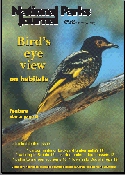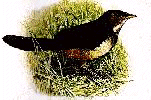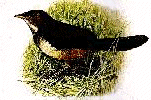|
|
|
Cover Story - Bird's
eye view |
Habitat
Loss in NSW... What say the
birds?
Kate Ravich
Chair of the Southern NSW and ACT Group of Birds Australia
and the Coordinator of the Birds in Backyards Program.
Also ...
Decline of woodlands birds a legacy of the past... by
Judie Peet
|
|
The Action Plan for Australian
Birds 2000 (1)
showed that one in five (20%) Australian native landbird species are now
threatened with extinction while two in three (63%) seabirds which breed in
Australia, are threatened (2). Potentially losing so many of
our native species justifiably makes us sad, but what are these sobering figures
really telling us? KATE RAVICH* writes...
|
| Birds are very good indicators
of sustainability. As they are ubiquitous, highly visible and occur high
in the food chain, they have the capacity to be reflective of underlying
environmental change. (3) International
studies show that there is a significantly higher occurrence of maximum
bird diversity (Important Bird Areas) in areas where there is good
biodiversity. (4) In fact, birds are such good
indicators of sustainability that in the United Kingdom they are used as
one of fourteen official Headline Indicators alongside more traditional
measures such as GDP and the employment rate.(3)
|

Major Mitchels at water
Photo: Bob Ravich
|
The finding that so many of our
Australian bird species are under threat, is a clear indication that Australia
is dramatically losing biodiversity. Focusing on landbirds, the generally
accepted primary cause for their decline is a loss of habitat, resultant from
land clearing and its associated problems such as salinity.
Let's look more closely at land
clearing. New data released in November, 2001 (5), based
on research undertaken by the Queensland Herbarium, the NSW Royal Botanic
Gardens and the NSW National Parks and Wildlife Service, revised the land
clearing rate up by 22% from previous estimations — 60,000 hectares/year being
cleared in NSW alone, between 1997 and 2001. Today in NSW,
there are less than 1% of intact native
grasslands remaining (6) (i.e. carrying a full
complement of native plant species); over 90% of pre-European woodland cover has
been removed from some districts, (e.g. intact grassy white box woodlands have
been reduced to less than 0.01% of their original several million hectares (7));
and wetlands, the engine houses of biological diversity in our often dry
landscape, are in many cases dying of thirst due to interference with the
natural flow patterns of our rivers, mainly due to irrigation demands (8).
Forests of all types are still reasonably well represented and well reserved, in
comparison to native grasslands and woodlands which are our most threatened
habitats.
Why are we continuing to clear so
much land, when the obvious indications are that Australia is rapidly losing
biodiversity?
In October, 2001, Birds Australia
together with the Bird Interest Group Network (BIGnet) held a seminar entitled
'Birds for the Future'. This included an Open Forum whose primary aim was to
assess why we are failing to achieve effective conservation of our native
habitats and how best to address this. Interestingly, the causes were much
broader and lower level than had been expected, but that in itself is important.
Perhaps our message has not been getting across effectively because our level of
approach has been too high?
The following is a brief summary of
the forum results:*
Attitude:
87% of problems identified could be attributed to uninformed or unilateral
attitudes. These ranged from a lack of financial value placed on conserved land
– particularly by financial institutions and government bodies, to mistrust
between stakeholders, e.g. farmers and conservationists.
Resources:
A lack of resources contributed to 56% of problems, particularly those linked in
the Economic, Prioritisation and Behavioural groups. These included a lack of
financial investment in conservation and a consequent lack of human resources -
including active membership of conservation groups.
Processes: The
methods used to undertake various activities, (i.e. processes), were identified
as a primary cause in 44% of problems, e.g. some farming, tourism and urban
development practices.
Research:
12.5% of problems could be attributed to a total absence of or insufficient
knowledge to:
¨ ensure
biological diversity is maintained on private/community land other than
in specificallyprotected areas like National Parks.
¨ ensure
that the management of National Reserves/Parks, which would act as store houses
for the future, resulted in the maintenance of comprehensive biodiversity.
¨ re-establish
degraded or lost habitats effectively.
The
most significant of these problems is 'attitude'. This pervades almost all
issues, and this is what we must change. "No easy task" I hear
you say, but as Dr Dean Graetz reminded us in his motivational presentation at
the 'Birds for the Future' Symposium (9), the Civil
Rights Movement in the USA transformed a whole society in just a very few years
through strong leadership, persistence, commitment, activating the moral
strength of the individual and turning it into political action and staying
focused on 'the prize'. In our case – 'the prize' is a future for Australian
native habitats and wildlife.
There
are many ways in which we can individually
contribute to changing attitudes and 'make conservation happen'. It seems to me
that we have a moral obligation to do so. If we don’t then we will loose 20%
of our landbird species and 63% of our breeding seabirds – in the not so
distant years ahead.
* Full details of these results and a
'Birds for the Future' Symposium Supplement is available from the Birds
Australia Sydney Office, Ph: 02 9436 0388
email: rosella63@bigpond.com
References:
1 Garnett, S.
and Crowley, G. 2000. Action Plan for Australian Birds. Birds
Australia/Environment Australia, Canberra.
2 G. Barry
Baker, Rosemary Gales, Sheryl Hamilton and Victoria Wilkinson. Albatrosses
and Petrels in Australia: A Review of their conservation and Management.
2001 (in press).
3 Fendley, M.
and Barrett, G. Birds as Headline Indicators Draft submission. Birds
Australia, Melbourne.
4 Bernun, L. 1999.
Are Important Bird Areas Reflective of Biodiversity? Address to BirdLife
International World Conference, Malaysia, October
5 New Data reveal
Australian Landclearing rates 22% worse. November, 2001. Report Queensland
Conservation Council, Australian Conservation Foundation, The Wilderness
Society.
6 Dr David Baker-Gabb:
Grasslands – Conservation status in NSW. Address to Birds for the Future
symposium. October, 2001.
7 Dr Andrew Fisher:
Woodland birds in NSW: horror, hallucination or hope. Address to Birds
for the Future symposium. October, 2001.
8 Dr Stuart Blanch:
Wetlands - Conservation status in NSW. Address to Birds for the
Future symposium. October, 2001.
9 Dr Dean Greatz:
Conserving Australian Birds: Keep your eyes on the Prize! Address to Birds
for the Future symposium. October, 2001.
Kate Ravich is the
Chair of the Southern NSW and ACT Group of Birds Australia
and the Coordinator of the Birds in Backyards Program.
|
Decline of woodlands birds a
legacy of the past...
by Judie Peet
Whilst current land clearing
is the major threat to birds’ woodland habitats, land use practices of
up to 50 years ago in the NSW sheep/wheat belt are now being felt. Bird
species are still disappearing today from areas which have seen no apparent
habitat change for decades.
Land managers must realise
that today’s decision may not reveal an obvious impact until many
years down the track. The results of clearing cannot be reversed in the
short term by revegetation as revegetation only replaces one element in
the landscape. The restoration of ecological processes is a natural
event that happens gradually over a long period of time, so protection
of existing native vegetation is much more important than attempts at
rehabilitation.
This is not to deny the huge
value of revegetation in already degraded areas – rather, it is to
reinforce the need to retain remaining native vegetation communities
across the landscape. Threats from increased numbers of foxes to
ground-dwelling birds such as the Malleefowl continue in the woodlands
area. However, the Goonoo State Forest’s fox control program appears
to be achieving success in reducing the number of foxes as the number of
reported Malleefowl sightings is growing.
In another region of the
west, the Hay Plains, I understand that foxes are also causing major
concern for the Plains Wanderers. Unfortunately these small
ground-dwelling birds ‘freeze’ on sight of foxes with inevitable
results.
Judie Peet is the Coordinator
of the inaugural Birds Australia/NPWS project to address the decline of
woodlands birds. She is based in Dubbo and may be contacted by email: miworld@iprimus.com.au |




